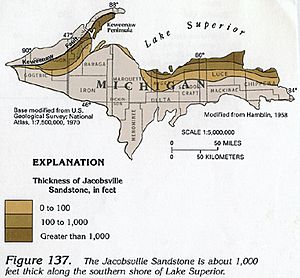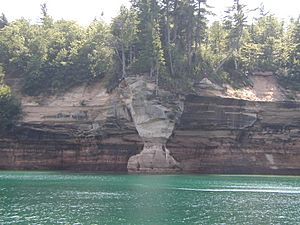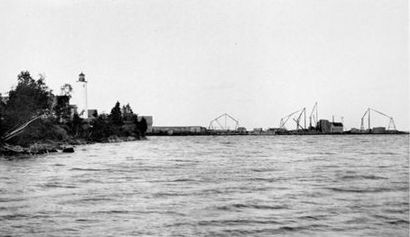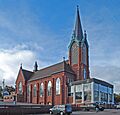Jacobsville Sandstone facts for kids
Quick facts for kids Jacobsville SandstoneStratigraphic range: Mesoproterozoic-Mid Cambrian |
|
|---|---|

Sample of Jacobsville Sandstone from Jacobsville, Michigan, in the A.E. Seaman Mineral Museum collection
|
|
| Type | Formation |
| Underlies | Munising Formation |
| Overlies | Freda Sandstone |
| Lithology | |
| Primary | Sandstone |
| Other | Conglomerate, siltstone |
| Location | |
| Region | |
| Country | |
| Type section | |
| Named for | Jacobsville, Michigan |
The Jacobsville Sandstone is a special type of red sandstone rock. It has cool light-colored streaks and spots. You can find it mostly in the northern part of Upper Michigan, some parts of Ontario, and under much of Lake Superior. People really liked this sandstone because it was strong and looked beautiful. It was used to build many buildings in both Canada and the United States. Quarries (places where stone is dug up) dug out this stone in Upper Michigan between about 1870 and 1915.
This sandstone has had many names over time. Some people called it redstone, brownstone, Lake Superior Sandstone, or Eastern Sandstone. In 1907, it got its official name, Jacobsville, after the town of Jacobsville, Michigan. This town was famous for producing a lot of this sandstone. Scientists don't fully agree on its exact age, but it formed sometime between the Mesoproterozoic Era and the Middle Cambrian period. This rock formed on land, not in the ocean, and it doesn't have any fossils.
Contents
What is Jacobsville Sandstone?
How it was named
Scientists started studying the rocks around southern Lake Superior in the early 1800s. Back then, they often used the name Lake Superior Sandstone for many different rock layers. They tried to tell the sandstones apart by dividing them into eastern and western parts, or by calling them "lower red" and "upper grey" sandstones.
In 1907, two scientists, A. C. Lane and A. E. Seaman, gave the Jacobsville Formation its current name. They divided the Lake Superior sandstones into three main types: Jacobsville, Freda, and Munising. The Jacobsville Sandstone was the "lower red" or "Eastern" type. They named it after Jacobsville, Michigan, because that town was well-known for its sandstone, including the "famous Portage Redstone."
Some scientists think Jacobsville Sandstone might be related to other sandstones like the Bayfield Group in Wisconsin or the Freda Sandstone. This is because they have similar rock types and minerals.
What it looks like
Jacobsville Sandstone is usually red because it has small amounts of iron. It also has patches of pink, white, and brown. You can see many white streaks and round spots on the sandstone. These spots are caused by water washing away some of the color, creating sharp lines between colors.
The rock is made up of different kinds of sandstone, from those rich in quartz to those rich in feldspar, and also some shale. It has four main types of rock within it: conglomerate (rock with pebbles), lens-shaped sandstone, thick sandstone, and red siltstone.
This sandstone is very strong and well-cemented. It doesn't have any signs of glacial deposits (like from ancient ice sheets) and, as mentioned, no fossils. The tiny grains that make up the sandstone are about 0.25 to 0.5 millimeters (0.01 to 0.02 inches) in size.
Where it's found
The Jacobsville Sandstone is found southeast of the Keweenaw Fault in the Keweenaw Peninsula. It also stretches south of Lake Superior further east in the Upper Peninsula. In Ontario, Canada, it's found under Sault Ste. Marie and along the lake shore. It also appears in a small area in Iron County, Wisconsin.
The thickness of the sandstone varies a lot. In Michigan, it can be from 5 feet (1.5 meters) to over 1,800 feet (550 meters) thick. This is because it was laid down on a very uneven surface. It also lies under most of Lake Superior, especially west of Munising, where it can be over 3,000 feet (910 meters) thick.
The Jacobsville Formation sits on top of older rocks called the Oronto Group. It is also found below the Munising Formation. This means it's part of a larger group of rocks called the Keweenawan Supergroup. You can see the Jacobsville Formation in many places in the Upper Peninsula, and less often in Ontario and Wisconsin. Cliffs made of this sandstone often have loose rock piles at their base and not much plant life. It's the oldest rock formation you can see at Pictured Rocks National Lakeshore, rising just a few feet above the lake. It's also a big feature on Grand Island in Hiawatha National Forest.
How it formed and its age
The Jacobsville Sandstone formed in places like rivers, lakes, and river deltas. Sand and gravel were carried by streams flowing north from the Northern Michigan Highlands. These highlands were once mountains formed during an event called the Penokean orogeny. When the streams reached the area that is now the southern shore of Lake Superior, they slowed down and dropped their sediment. This sediment eventually became the Jacobsville Sandstone.
The area where it formed was wet and humid. This environment caused iron in the minerals to change, giving the sandstone its red color. More changes happened before the Munising Formation was laid down, creating the bands of color we see today.
Scientists have different ideas about the age of the Jacobsville Formation. It could be from the late Mesoproterozoic Era (about 1.03 to 1.07 billion years ago) or the Middle Cambrian period. Early geologists thought it might be even younger. We know its age is somewhere between 1.1 billion and 540 million years ago because of the rock layers above and below it.
It's hard to figure out the exact age because the Jacobsville Sandstone formed on land, so it doesn't have any fossils that could help date it. Also, there are no igneous intrusions (like solidified magma) within it to help set a lower age limit. Because the Jacobsville Formation fills part of the Midcontinent Rift System (a giant crack in the Earth's crust where Lake Superior formed), it's usually considered to be from the late Precambrian age in the United States. In Canada, it's often thought to be from the Cambrian age.
A study in 2010 suggested it likely formed between 940 and 910 million years ago. Since the Jacobsville Formation doesn't have any signs of glaciers, it probably didn't form during a "Snowball Earth" event (when much of Earth was covered in ice). Also, the rock layer above it, the Munising Formation, has many fossils, but the Jacobsville does not. This suggests the Jacobsville formed before large, complex life forms evolved, which was about 800 million years ago.
Jacobsville aquifer
The Jacobsville Sandstone acts like a giant sponge underground, holding water. This is called the Jacobsville aquifer. It covers a huge area of about 4,363 square miles (11,300 square kilometers). Even though it's sandstone, water mostly moves slowly through cracks in the rock, down to about 100 to 150 feet (30 to 46 meters) deep. In 1985, people used about 6.5 million US gallons (24,600 cubic meters) of fresh water from it every day. Some wells in this aquifer have higher levels of uranium and radon, especially in the Keweenaw Peninsula.
How it was extracted
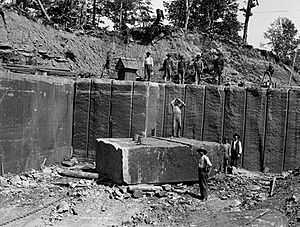
The first time Jacobsville Sandstone was dug up was in Alger County in the 1860s. Two companies provided stone to build nearby furnaces for the iron industry. The widespread digging of this sandstone for commercial use began around 1870. The industry was busiest in the early 1890s.
Over the years, about 32 quarries operated. They were mainly found near Jacobsville and Marquette, with others along the Lake Superior coast. The industry started to slow down and mostly ended around 1915, when World War I began.
John Henry Jacobs was a very important person in the Jacobsville Sandstone industry. The town of Jacobsville was even founded in 1884 when he opened his first quarries there. Both the sandstone and the town are named after him.
The two main types of Jacobsville Sandstone that were dug up were redstone and brownstone. Redstone came from the Jacobsville area and could be a solid color or have many different colors. A purplish-brown type of brownstone, called rain-drop, was said to be the "most handsome stone quarried on Lake Superior." Brownstone and rain-drop came from Marquette. Until the early 1900s, people often called Jacobsville Sandstone by names like Lake Superior Sandstone, brownstone, or redstone, adding the place it came from, like "Marquette brownstone."
Quarrying techniques
The sandstone was dug up in large blocks (called dimension stone), smaller chunks (ton stone), or irregular pieces (rubble stone). Dimension stone was the most valuable. These large blocks usually measured about 8 by 4 by 2 feet (2.4 by 1.2 by 0.6 meters). The smaller, leftover pieces were called rubble stone. They were sold cheaply or thrown away. Sandstone was dug up between April and November, because cold winter weather could damage the stone.
When a new quarry opened, workers first had to remove up to 50 feet (15 meters) of dirt, rocks, and shale on top. This was done by blasting. If there wasn't a natural cliff face, long, narrow channels were cut into the rock. Then, a "key" block was removed from between the channels, creating space. Once the key was out, holes were drilled horizontally under the block to be quarried. Workers then used wedges to crack the block open. These large blocks were then broken into smaller, usable sizes with wedges and sledgehammers. Finally, the blocks were moved by tramcar to docks or loaded directly onto ships. From there, the sandstone was shipped to ports along the Great Lakes and then moved inland.
Why the industry declined
| Year | Total value |
|---|---|
| 1899 | $178,038 |
| 1900 | $132,650 |
| 1901 | $174,428 |
| 1902 | $188,073 |
| 1903 | $121,350 |
| 1904 | $74,868 |
| 1905 | $123,123 |
| 1906 | $65,395 |
| 1907 | $53,003 |
| 1908 | $39,103 |
| 1909 | $36,084 |
| 1910 | $31,233 |
| 1911 | $12,985 |
| 1912 | $16,438 |
| 1913 | $19,224 |
| 1914–1916 | — |
The World's Columbian Exposition in Chicago in 1893, with its "White City," started a new trend in architecture. People began to prefer light-colored marbles and limestones instead of darker stones like Jacobsville Sandstone. This change in style quickly hurt the sandstone industry, especially around Lake Superior.
In 1896, an official from Michigan said that architects were choosing other materials. They felt that too much sandstone was being used, and they wanted a change in style and color. The industry started to decline, and many quarries closed because there was enough sandstone already mined to meet the lower demand.
After a few years, the industry saw a small comeback around 1900. However, Michigan's total sandstone production peaked in 1902 at a value of $188,073. By 1911, it had dropped to just $12,985. By 1914, fewer than three companies were still producing sandstone in the state.
The director of the Michigan Geological and Biological Survey said the decline was partly due to the Depression of 1893. Also, the quarries were far from major cities where the stone was needed. New materials like artificial stone, concrete, and brick became popular and cheaper. Brick makers also actively campaigned against using stone. Around 1897, there was a controversy during the building of the Wayne County Courthouse. Jacobsville Sandstone was initially chosen, but then it was replaced with stone from Ohio. Some people claimed the Jacobsville Sandstone was not strong enough.
The exact end of the industry is not clear, but most quarries closed by about 1915. The last active quarry closed between 1923 and 1926. Even after the industry ended, some new buildings still used Jacobsville Sandstone. This stone was often taken from old buildings since new stone was hard to get.
The town of Jacobsville, which grew because of the sandstone industry, had about 800 people in 1897. But by the mid-1960s, its population had dropped to only seventy people.
Other uses and future
While Jacobsville Sandstone was mainly used for building, it has other potential uses. The rock contains a lot of iron, but this hasn't been explored much. There has also been interest in finding uranium in the Jacobsville formation in the Upper Peninsula. Between 2003 and 2010, two companies spent $1.6 million looking for uranium there. Some people are also interested in digging up the sandstone again for building projects.
The International Union of Geological Sciences has recognized Jacobsville Sandstone as a Global Heritage Stone Resource. This means it's an important stone with historical and cultural value.
How it was used
Material qualities
Jacobsville Sandstone was a popular building material because it was strong, lasted a long time, and looked good. It was especially good at resisting extreme temperatures, like fire, and the freeze-thaw cycle in cold northern climates. The Mining Journal reported in 1875 that its fire-proof qualities were tested in the Great Chicago Fire. They said that walls made of Lake Superior brownstone stood strong without cracks, while marble fronts crumbled.
The sandstone was easy to get in large amounts and shipping it by the Great Lakes made it even cheaper. It was also easy to work with and carve, so it could be used for many parts of a building. The most desired stone was one without white spots and with a solid color. The Richardsonian Romanesque building style, which uses colored stone, helped make the sandstone popular. Buildings in this style looked strong and stable, which fit well with the character of the Lake Superior region.
Buildings and structures
Many buildings in the Upper Peninsula, across the United States, and in Ontario, Canada, use Jacobsville Sandstone. In the Upper Peninsula, you can see it in buildings like The Calumet Theatre, Saint Ignatius Loyola Church, and several buildings in the Quincy Street Historic District. Elsewhere, the sandstone was used in the original Waldorf-Astoria Hotel in New York City.

The smaller, irregular pieces of stone (rubble stone) were often used for building foundations, docks, breakwaters, and piers. Jacobsville Sandstone has also been used as a material in concrete and for flat paving stones (flagstone).
Images for kids
-
Sample of Jacobsville Sandstone from Jacobsville, Michigan, in the A.E. Seaman Mineral Museum collection
-
Quarry of the Kerber-Jacobs Redstone Company at Portage Entry about 1897
-
Saint Ignatius Loyola Church in Houghton was built with Jacobsville Sandstone.
See also
 In Spanish: Jacobsville Sandstone para niños
In Spanish: Jacobsville Sandstone para niños


